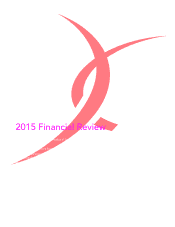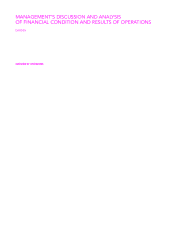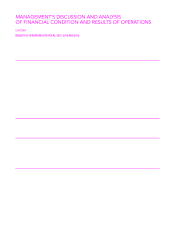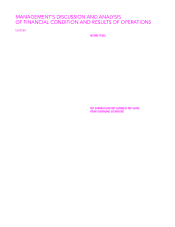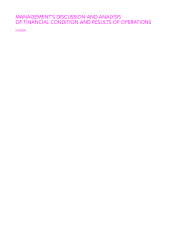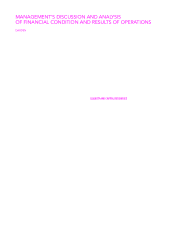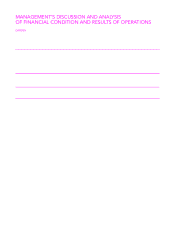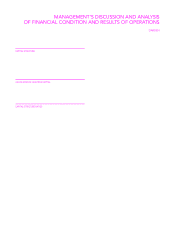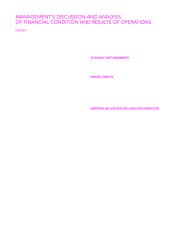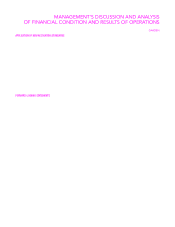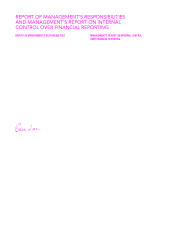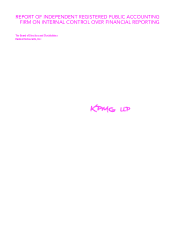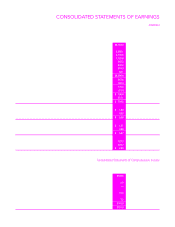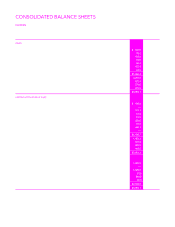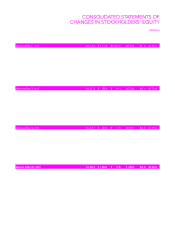Red Lobster 2015 Annual Report Download - page 23
Download and view the complete annual report
Please find page 23 of the 2015 Red Lobster annual report below. You can navigate through the pages in the report by either clicking on the pages listed below, or by using the keyword search tool below to find specific information within the annual report.
DARDEN RESTAURANTS, INC. | 2015 ANNUAL REPORT 19
MANAGEMENT’S DISCUSSION AND ANALYSIS
OF FINANCIAL CONDITION AND RESULTS OF OPERATIONS
DARDEN
The Revolving Credit Agreement matures on October 24, 2018 and the
proceeds may be used for commercial paper back-up, working capital and
capital expenditures, the refinancing of certain indebtedness, certain acqui-
sitions and general corporate purposes. Loans under the Revolving Credit
Agreement bear interest at a rate of LIBOR plus a margin determined by
reference to a ratings-based pricing grid (Applicable Margin), or the base
rate (which is defined as the highest of the BOA prime rate, the Federal Funds
rate plus 0.500 percent, and the Eurocurrency Rate plus 1.00 percent) plus
the Applicable Margin. Assuming a “BBB-” equivalent credit rating level, the
Applicable Margin under the Revolving Credit Agreement will be 1.300 percent
for LIBOR loans and 0.300 percent for base rate loans. As of May 31, 2015,
we had no outstanding balances under the Revolving Credit Agreement.
During fiscal 2015, primarily utilizing proceeds from the sale of Red
Lobster, we retired approximately $1.01 billion aggregate principal of long-term
debt, comprised of $278.1 million aggregate principal of our 4.500 percent
senior notes due 2021, $338.9 million aggregate principal of our 3.350 percent
senior notes due 2022, $80.0 million aggregate principal amount of our
3.790 percent senior notes due 2019, $210.0 million aggregate principal
amount of our 4.520 percent senior notes due 2024 and $100.0 million
aggregate principal amount of our outstanding 7.125 percent debentures
due 2016.
In fiscal 2015, we recorded approximately $91.3 million of expenses
associated with the retirement. These expenses included cash components for
repurchase premiums and make-whole amounts of approximately $44.0 million
and non-cash charges associated with hedge and loan cost write-offs of
approximately $47.3 million. These amounts were recorded in interest, net in
our consolidated statements of earnings.
At May 31, 2015, our long-term debt consisted principally of:
• $270.0 million unsecured, variable-rate, amortizing term loan,
maturing in August 2017;
• $500.0 million of unsecured 6.200 percent senior notes due in
October 2017;
• $121.9 million of unsecured 4.500 percent senior notes due in
October 2021;
• $111.1 million of unsecured 3.350 percent senior notes due in
November 2022;
• $10.0 million of unsecured 4.520 percent senior notes due in
August 2024;
• $150.0 million of unsecured 6.000 percent senior notes due in
August 2035; and
• $300.0 million of unsecured 6.800 percent senior notes due in
October 2037.
We also have $15.0 million included in current liabilities as current portion
of long-term debt associated with the term loan, which reflects the annual
principal amortization payment due in August 2015.
The interest rates on our $500.0 million 6.200 percent senior notes due
October 2017 and $300.0 million 6.800 percent senior notes due October
2037 are subject to adjustment from time to time if the debt rating assigned to
such series of notes is downgraded below a certain rating level (or subsequently
upgraded). The maximum adjustment is 2.000 percent above the initial interest
rate and the interest rate cannot be reduced below the initial interest rate. In
October 2014, Moody’s Investors Service downgraded our senior unsecured
ratings to “Ba1” from “Baa3” resulting in an increase of 0.250 percent in the
interest rates on our senior notes due in October 2017 and October 2037,
effective as of the first day of the interest period during which the ratings
change took place. Accordingly, our annual interest expense increased by
$2.0 million as a result of these rate adjustments.
Through our shelf registration statement on file with the SEC, depending
on conditions prevailing in the public capital markets, we may issue unsecured
debt securities from time to time in one or more series, which may consist of
notes, debentures or other evidences of indebtedness in one or more offerings.
From time to time, we may repurchase our outstanding debt in privately
negotiated transactions. Such repurchases, if any, will depend on prevailing
market conditions, our liquidity requirements and other factors.
Effective October 13, 2014, 12 new directors were elected to the Company’s
board, replacing the previous 12 directors. At a meeting held on July 24, 2014,
the Company’s then current Board of Directors sought to address the potential
adverse consequences to the Company from a change in control of the
Company’s board, including a potential event of default or acceleration of its
indebtedness under the provisions of our Revolving Credit Agreement or other
debt agreements. As a result, the then current Board of Directors adopted
resolutions approving and nominating the 12 new directors solely for purposes
of addressing the provisions in the Revolving Credit Agreement and other
debt agreements so that the election of 12 new members to our board did
not constitute a change in control triggering an event of default under those
agreements. The board’s actions do not affect any other agreements that
may have change in control triggers.
During fiscal 2015, we conducted a comprehensive evaluation of a wide
range of options for the potential monetization of our real estate portfolio. As
a result of this evaluation, we undertook the following strategies:
• We listed approximately 75 properties for sale-leaseback transactions,
14 of which were completed in fiscal 2015 with the remaining properties
expected to be completed in fiscal 2016. The 14 completed transactions
generated proceeds of $44.9 million;
• We listed our corporate headquarters to explore different monetizing
structures, including a sale leaseback; and
• In June 2015, our Board of Directors approved a plan to transfer
approximately 430 of our owned restaurant properties into a REIT,
with substantially all of the REIT’s initial assets being leased back to
Darden. We expect to complete the REIT transaction during fiscal 2016.
We expect to utilize the proceeds generated from these transactions to
pay down our long-term debt. While we have conducted substantial analysis
of the feasibility of implementing a REIT transaction, a significant amount of
work remains and there can be no assurance we will be able to successfully
complete the transaction and establish a REIT.
From time to time, we enter into interest rate derivative instruments
to manage interest rate risk inherent in our operations. See Note 10 to
our consolidated financial statements in this report, incorporated herein
by reference.


